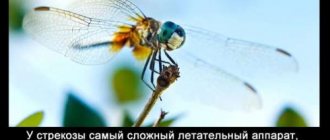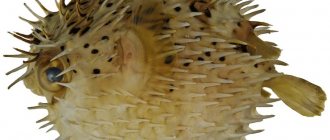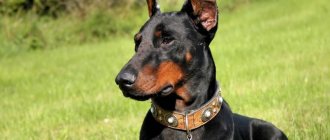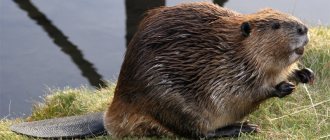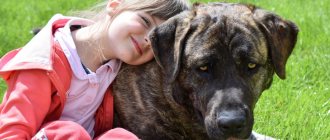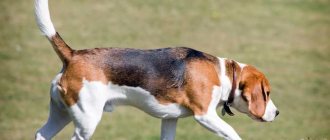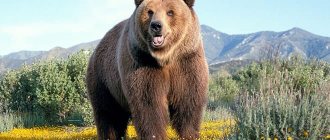Biological characteristics of dogs;
The domestic dog is classified as kingdom-animals, phylum-chordates, subphylum-vertebrates, class-mammals, order-carnivores, family-canids (Cidae), genus-wolves, species-domestic dog [17].
Based on the systematic affiliation and lifestyle of dogs, the definition is a pack predator. Those. these animals are social, and due to the fact that they live in society, they are able to survive and adapt to various environmental conditions and its changes. Since dogs are pack animals, an important feature of their lifestyle is the presence of a hierarchical pack structure.
The dog is a crepuscular predator; its daily rhythm is different from that of humans. The hours of morning and evening activity are acceptable for this species; the dog’s daytime rest does not interfere with humans. In addition, having shallow, easily interrupted sleep, the dog quickly moves on to activity at any time of the day when it is needed.
Puberty of most dog breeds occurs at the age of 7 - 8 months. However, at this age it is not advisable to use animals as producers from a biological point of view. In other words, the appearance of signs of puberty (estrus in females, readiness for mating in males) cannot serve as a sufficient argument for using dogs as breeders [17].
Sexual activity in females occurs cyclically, usually twice a year. In some individuals, it is monitored less frequently - at intervals of 12 months - neuro-humorally. The duration of pregnancy in females is 58 - 62 days [10].
In the first half of pregnancy, fetuses develop slowly. In the second half of pregnancy, the fetuses develop very quickly, which is noticeable by the increase in the volume of the bitch’s abdominal cavity. Approximately 5 - 7 days before giving birth, the bitch experiences swelling of the mammary glands and slight swelling of the perineum and external genitalia [4].
The duration of labor in dogs is 4 - 6 hours. As a rule, a healthy and well-developed dog does not require assistance during birth (with the exception of some breeds, such as the English Bulldog). In a litter of most dog breeds, the number of puppies ranges from 6 to 10.
It is believed that for all service dog breeds, only dogs with excellent service qualities and whose ancestors have been successfully used in service in a number of generations are allowed for breeding use. However, dogs that perform real service are often not used for breeding. In addition, there is also the practice of sterilizing working dogs in order to avoid both unwanted matings and to reduce the degree of distraction of animals from work.
Of great importance for working breeds of dogs and all dogs in general is the peculiarities of their perception of the surrounding world, which make it possible to determine their value in work.
The dog has good three-dimensional vision in the sector located in front of the head. To the side of itself and into the distance, the dog sees contours without distinguishing details, since this is where the zone of flat vision is located, but it perfectly distinguishes moving objects. The field of vision of the human eye is a circle, and the field of vision of a dog is “stretched” to the sides. The axes of the eyes in humans are parallel, but in dogs they are such that the optical axes diverge by 20 degrees. It is thanks to this that a dog’s field of vision is 240 - 250, while a person’s is 60 - 70 degrees less. Visual acuity is not needed for a dog. Here it is more important to see equally well at any time of the day and identify the object of hunting. It is from here that dogs have the ability to see a moving object better than a stationary one: due to the larger number of rods in the eye, a dog can see a moving object at a distance of 800 - 900 m, and a stationary one only from 600 m.
The human retina contains 3 types of cones, each of which responds to a different range of color. Some are sensitive to long-wave radiation: red and orange, others to medium-wave radiation: yellow and green, and others to blue, indigo, and violet. And the peculiarity of the dog’s retina is that they do not have cones that are sensitive to red color, due to this they cannot perceive the difference between yellow-green and orange-red colors. This feature of canine vision is similar to color blindness in humans [5].
Features of indoor breeds
The main task of decorative dog breeds is to bring joy to their owner. They are not suitable for work or service, but quickly become true friends with whom you can have fun, relieve stress, or sit next to them on the couch. As a rule, decorative dogs have an attractive appearance and small size, which is convenient for keeping in an apartment.
This group of dogs includes breeds specially bred to decorate human life, many of them have ancient roots; in the past, such pets emphasized the high position of their owner. The ancestors of some indoor dogs were previously used for hunting and service, but today they have not retained their qualities.
Nikolaev regional public canine organization (MOGKO) "TRON"
- Elena: Dear club members, we will be glad to see you at the new address on Galina Petrova St., 5 (Veterinary clinic “Lord”), Evis station district. The schedule is the same: Monday or Friday from 18-20, tel. for contact, We are waiting for everyone at the housewarming party after the New Year holidays! And I won’t break it either
- Elena: Natalia, thank you very much for the articles.
- Natalia - Flip : Photo album created
- Elena: Natalia, organize a photo album Exhibition KSFU 11/23/19.
- Natalia - Flip: Photo album has been created.
- Elena: Natalia, please make a daddy “to the Kovalevsky forest for MUSHROOMS”
- Elena: School? Did not hear!
- Ekaterina: tell me, is there a grooming school in Nikolaev?
- Elena: On November 9 (Saturday) it is planned to go to classes to practice elements of general obedience, searching the area to find mushrooms with mushroom pickers. barbecue and good mood! For more detailed information, please call (093)851-23-59,
- Elena: Thank you Natalia! The photo album is almost loaded!
- Natalia - Flip: Photoalue created
- Elena: Natalia, please make a folder in the photo album “CAO Championship 10/19/19.”
- Elena: Photos are uploaded! If anyone has any more photo reports, SEND IT!
- Natalia - Flip : Photo album created
- Elena: Natalia, please make a daddy 05.10.”Amber Nikolaev 2019″
- Natalia - Flip: Done.
- Elena: Natalia, thank you very much for the transfer! Please make another album Odessa double CACIB, 09.15.19.
- Natalia - Flip: Photo album moved
- Elena: Natalia, please move the folder “Sea 08/24/19” to the “Interesting from life” section. "
- Natalia - Flip : Photo album created
- Elena: 24 08.19 we are going to the sea, if you want to soak up the sun at the end of summer, please contact the club immediately!
- Elena: Natalia, please transfer 2 folders Seaside holidays to the “Interesting from life” folder.
- Natalia - Flip: Edited everything
- Elena: Natalia, where is another folder dated 06/08/19?
- Elena: Thank you very much!
- Natalia - Flip: Already created
- Elena: Natalia, where is daddy in the “photo album”.
- Natalia - Flip: Elena Mikhailovna! The forum has been corrected.
- Elena: photo from the sea on the Forum in General Questions in the Club Life section!
- Elena: People, a small request, whoever has unnecessary jeans or tight pants, donate to the club!
To write a message, log in
How to choose a decorative breed?
Such breeds are ideal for living in the city, even in a small apartment, and require minimal experience from the owner. The decision to choose one breed or another should be deliberate - despite its small size, the dog needs good nutrition, walks and even training.
When choosing, you should pay attention to the exterior and behavioral characteristics. For those who care about cleanliness in the house, breeds with hard hair and no pronounced shedding are suitable. If you plan to use your pet as a walking companion, then you should pay attention to active dogs. In addition, small dogs are not very suitable for families with children - they can unknowingly injure the pet during play.
When purchasing a puppy, you should check the pedigree and health of the animal. It is best to contact specialized nurseries, where parents are selected correctly and mating conditions are observed.
Brief description of dog biology
The appearance and behavior of domestic and wild representatives of the canine family are very different. By how much a dog looks like a wolf, you can tell which one is wild and which one is domestic.
Currently there are about 400 dog breeds. Perhaps no other biological species has such external diversity; a half-pound chihuahua and a 90-pound mastiff belong to the same canine family. For example, cat breeds are not as diverse. All existing dog breeds are bred through careful selection of individuals with certain qualities. Perhaps they still have one common ancestor. ,
There is an opinion that the average mongrel (canine experts call them pariah dogs) is a kind of “primitive” type of dog. Indeed, with all the diversity of mongrels, they have a number of common features: average weight (20-30 kg), average height, elongated muzzle, protruding ears, hanging tail. In any country in the world, most mongrels will fit this description. And in fact, a mongrel is nothing more than a mixture of all breeds.
It cannot be said that the wolf gained a lot by turning into a dog. On the contrary, the weight and volume of a dog’s brain is 30 percent less than that of a wolf, and its vision, hearing and sense of smell are weaker. If a wolf finds a lost trail in a matter of minutes, the best sniffer dog works for almost an hour.
And so it is in everything. This is especially true for nutrition. If wild canines are classic predators, then the domestic dog is more likely to be an omnivore. Living for many centuries next to humans, the dog acquired some “human” food needs, as well as specific diseases associated with eating disorders.
But it should be noted that the union of man and dog greatly changed both of them. The English writer D. McCaig puts it this way: “The fact that we influenced the dog’s genetics requires no explanation, but it is hardly known how it changed us. Since dogs' hearing and sense of smell are better developed, people were able to concentrate on visual sensations. Dogs, by making us better predators, gave us time to think. In short, they civilized us."
Fighting dog breeds
They were bred by selection of physical characteristics and aggressive character. They require special attention in maintenance and training. Fighting breeds include the American bully, Dogo Argentino, and pit bull.
Tosa Inu
A large breed of Japanese origin, weighing up to 90 kg. Dogs do not require a command to attack an enemy; they make the decision on their own. They practically feel no pain. European Tosa Inus have a developed protective instinct. In Japanese dogs, fighting qualities come first.
(066)743-97-63, (068)808-27-62 Natalia
Dogs who have passed certification and wish to continue training in the same program, classes are free!
FOR CLUB MEMBERS!
Free courses for “Young dog handler”. Children from 6 to 16 years old Classes are held in the club office
on Mondays and Fridays from 17.00-18.00 ,
at the address: st. Shevchenko, 71 (corner of K. Liebknecht), office 426 (4th floor).
For information please call:
(066)197-82-58,, (097)27-012-48
Top decorative breeds
We have selected photos and names of the 30 most famous decorative dog breeds. Below you will find a description of each of them, with photographs and the history of their appearance, which will help you decide on the choice of a pet.
American Hairless Terrier
The breed was developed in the USA in 1972. These are medium-sized dogs, males grow up to 40 cm at the withers. Despite their ancestors, hairless terriers did not inherit the ability to kill rats, so they began to be bred only for decorative purposes. Today there are two varieties of the breed - completely hairless dogs and terriers with little hair. The Hairless Terrier is a long-lived breed; with proper care, they can live up to 16 years. The price for puppies starts from 20,000 ₽.
Affenpinscher
One of the smallest representatives of German Pinschers. Adults do not exceed 30 cm at the withers. A distinctive feature of Affenpinschers is that their muzzle resembles that of a monkey, which is reflected in the name of the breed. This is an active and mobile dog that is undemanding in terms of living space and maintenance. They quickly learn training and find a common language with other animals in the apartment. The average cost is 35,000 ₽.
Belgian Griffon
This Belgian breed is memorable for its appearance - their hard coat forms a rather thick coat that cannot renew itself. A characteristic beard forms on the muzzle. The height of adult dogs is only up to 20 cm, but despite their small size, they are hardy and active animals. When choosing a Belgian Griffon as a pet, you should remember that they need regular trimming of their coat. Price from 30,000 ₽.
Bichon Frize
A decorative breed that was formed by Belgian and French breeders. The Bichon Frize belongs to the group of lapdogs, so the dog has adopted all their best qualities - focus on people, lack of shedding, playful character. If properly maintained, they can live up to 15 years. There is also a drawback - the French lapdog does not tolerate loneliness well. You can buy a puppy from 20,000 ₽.
Boston Terrier
A small decorative breed of dog that combines the appearance of a bulldog and the temperament of a terrier. Unlike other breeds with a flattened muzzle, the Boston Terrier suffers less from increased drooling and respiratory problems. When keeping it, it is important to take into account that dogs are highly dependent on the weather, as they have slow heat exchange. Bostons are distinguished by expressive facial expressions, which allows them to always be the center of attention. The average price is 35,000 ₽.
Brussels Griffon
This breed of lap dog was bred in Belgium, where it gained enormous popularity among people of all incomes. The dog has an interesting appearance, a thick beard directed in different directions. This is a very active animal with developed intelligence. The Brussels Griffon always chooses one person as its owner and easily gets along with other pets in the apartment. Cost from 30,000 ₽.
West Highland White Terrier
Initially, the breed was bred to hunt small game, but due to its decorative appearance, it began to be used only as a pet. The West Highland White Terrier has a beautiful appearance and a very active character. Like other representatives of terriers, they combine playfulness and fearlessness, as well as hunting instincts - the dog should not be kept in the same house with small animals. The price of puppies is from 65,000 ₽.
Havanese Bichon
This is a decorative dog of the lapdog group with a tobacco or white coat. Today the breed is on the verge of extinction and is exclusive in many countries. The Havanese Bichon is easy to train and keep in an apartment, but it is important to pay attention to the coat - it is prone to shedding. Due to their unique sociability in the United States, representatives of the breed are recommended for single people and retirees.
Yorkshire Terrier
One of the most popular decorative and indoor dog breeds. Initially, the Yorkshire Terrier was used to hunt rats, but today many representatives of the breed have lost these instincts. This is a small and beautiful dog with a unique type of coat, which in structure resembles human hair. The Yorkie is a sociable animal that does not tolerate loneliness well. Despite their decorative appearance, they combine endurance, courage and intelligence. You can buy a puppy from 15,000 ₽.
Cavalier King Charles Spaniel
The breed was bred in England in the 17th century, where it became widespread among noble people. The dog is very dependent on humans, needs communication and tactile contact. She is practically not subject to mood swings and is very trainable. When caring for them, it is important to pay attention to the health of the ears - due to their hanging shape, they are susceptible to a number of diseases. The average cost is 70,000 ₽.
Keeshond
Decorative variety of German Spitz. Representatives of the breed have an active character and love long walks. Their long fur is practically odorless and is not afraid of water. These are smart animals that learn quickly and easily. Keeshonds still do not have official recognition by the FCI, so participation in international exhibitions is impossible. Price from 20,000 ₽.
Chinese Crested Dog
One of the most recognizable toy dogs in the world. It is distinguished by an almost bald body and large ears framed by long fluff. The Chinese Crested Dog is a good companion that needs human company. When choosing this breed, you should remember that clothing is required for walks in the cold. Due to their innate stubbornness, problems with training are possible; it is recommended to contact a professional dog handler. The cost starts from 15,000 ₽.
Lhasa apso
The breed has ancient Tibetan roots; according to the official version, the name translates as “a dog that looks like a goat.” The Lhasa Apso is a close relative of the Pekingese, but their appearance is strikingly different from them. These are small and fluffy animals with fairly long hair, which grows especially quickly on the head. All representatives of the breed have an innate guarding instinct and the ability to bark loudly. Despite their plush toy appearance, the decorative Lhasa Apso does not get along well with small children. You can buy a puppy for 50,000 rubles.
Maltese, or Maltese
An Italian breed of decorative dogs with an interesting “doll” appearance. The Maltese is loved for its hypoallergenic snow-white coat, sociable character and ability to adapt to the owner’s temperament. When keeping, you should know that the Maltese dog is picky about food and prone to obesity. They also love to bark, sometimes for no reason. The dog quickly becomes attached to a person and does not tolerate prolonged loneliness. A pet left to its own devices often begins to damage objects. Price from 70,000 ₽.
Maltipoo
A new breed created by crossing a Maltese and a Poodle. From them they received a decorative appearance, good health and a love of outdoor games, which persisted until old age. The dog does not tolerate loneliness well and becomes attached to the person. This is a pet for homebodies - they do not like long walks and serious physical activity. Maltipoos are not recommended for families with children; their fragile bones make them susceptible to injury. It is difficult to find puppies, since the breed is new, and no more than 6 puppies are born in a litter.
Mini bull terrier
The modern standard of this breed was formed in 1991. Externally, the dog is a copy of the standard bull terrier, differing from them only in size. The height of adult individuals does not exceed 35 cm, and their weight is 8 kg. This is a sociable and active dog that does not tolerate loneliness well. They have immense love for humans, but treat other animals with aggression. When choosing this decorative breed, it is important to consider that strict training and warm clothing are required for walks in cold weather. The cost of puppies is from 45,000 ₽.
Pug
An ancient breed of decorative dogs originally from China. Pugs are great for keeping in a small apartment, and also as a first dog for novice owners. This is a friendly dog towards humans and other animals, capable of adapting to any lifestyle. Due to their physiological characteristics, they do not tolerate high temperatures and physical activity well, so training should be moderate. If you have a tendency to become obese, it is important to plan your diet correctly. The average price is 20,000 ₽.
Petersburg orchid
An original breed of decorative dogs with long hair, bred in Russia in 1997. There is still no FCI recognition; breeding is carried out by the only kennel club in St. Petersburg. Orchid is an excellent choice for homebodies, since the pet does not need mandatory walks. They are able to adapt to the owner’s mood and do not express aggression even towards strangers. Possibility of sharing with other animals. Unlike many other small breeds, the St. Petersburg Orchid has no problems with bearing puppies and giving birth. The puppy can only be purchased by appointment.
Pomeranian Spitz
Decorative dog originally from Germany. They fell in love with society for their toy appearance, gentle character and friendliness towards people. They become attached to their owner and are distinguished by good guard skills - in the event of a threat, the Spitz signals danger. Only an apartment or private house is recommended for maintenance. The Pomeranian Spitz needs regular walking, grooming and proper nutrition. Due to its innate stubbornness, the breed is not suitable for beginners. Cost from 20,000 ₽.
Pomsky
The breed was bred in 2013 in the USA, but has not yet received recognition from the RKF and FCI. Externally, the Pomsky is a smaller copy of a husky, up to 40 cm high. The first individuals were obtained by crossing a husky with a Pomeranian Spitz. From them they inherited a decorative appearance, including a tendency to heterochromia (different colors of the iris), as well as an active character. The dog needs regular activity and training. Since the breed is young, there is no data on its abilities yet. Buying a puppy is extremely difficult.
Prague Ratlik, or Czech Ratlik
One of the smallest European dog breeds, but despite its popularity, there is still no FCI recognition. Prague rat rats were bred to hunt rodents, but due to a decrease in the need for this activity, they began to be kept as a decorative pet. The dog has not lost its hunting instincts and is hostile towards small rodents. There are two varieties of the breed - short-haired and semi-long-haired rats. When choosing a ratlik as a pet, it is important to consider that they love to be the center of attention and need physical activity. You can buy a puppy from 60,000 ₽.
Petit Brabançon
This decorative breed comes from Belgium and is a relative of the Griffon. The Petit Brabançon is distinguished by its balance and sociability. They do not start barking without a reason and are calm towards other animals and strangers. As the dog grows older, it gradually loses its playfulness, but still needs exercise. The Petit Brabançon is highly trainable and sensitive to the mood of its owner, making it suitable for novice dog breeders. Price from 25,000 ₽.
Poodle
All subspecies of poodle (large, small, dwarf and toy) are decorative breeds, differing only in size. This is one of the most obedient and intelligent dog breeds in the world. They have not only outstanding intelligence, but also a sense of smell, which makes them possible to use for hunting. The poodle is capable of serious loads, but can also adapt to the passive lifestyle of its owner. They are not prone to aggression; they show only good nature towards people. The cost depends on the variety.
Russian toy terrier
A miniature breed of decorative dogs, originated in Russia. Due to their size, they are ideal for keeping in small apartments. Russian Toy Terriers rarely show aggression, but they are also good watchdogs. They are distinguished by their developed intelligence, thanks to which they quickly learn to manipulate a person. When choosing this breed, you should remember that the toy terrier does not tolerate cold well and also has increased excitability. Puppies can be purchased from 15,000 ₽.
French Bulldog
The breed belongs to the group of decorative and companion animals. The French Bulldog is a typical city dog, but it requires exercise to live a comfortable life. They do not tolerate high temperatures well, and problems with the respiratory system are possible. Not suitable for connoisseurs of cleanliness, bulldogs can drool and are prone to increased gas production and snoring. Despite all the disadvantages, they become wonderful friends who love communicating and playing with children. The average price is 30,000 ₽.
miniature pinscher
A representative of the small German Pinschers, the breed was developed in the 18th century. This is an active and noisy dog that loves to play with people. The miniature pinscher has a developed intellect, a stable psyche and a tendency to dominate. They get along well with small children and are able to live comfortably even in a small apartment. This decorative breed is one of the best for novice dog breeders. You can buy a puppy from 15,000 ₽.
Chihuahua
A decorative breed of Mexican origin, which has gained popularity around the world as a pet. They easily adapt to any conditions, respond well to training and love communication with their owner. Today, long-haired and smooth-haired varieties of Chihuahuas have been bred, differing only in the type of coat. The dog has an innate touchiness and does not tolerate loneliness well. Cost from 15,000 ₽.
Shih Tzu
Tibetan decorative dog, known since the 15th century. Initially, Shih Tzus were kept in monasteries, where they acted as living alarms. Today it is a popular decorative pet with a beautiful exterior. Adult animals have a stable psyche, love walks and are patient with strangers. They do not bark over small things, so they are considered silent. When choosing a Shih Tzu as a family pet, it is important to remember that they do not tolerate loneliness well and need grooming. You can buy a puppy from 20,000 ₽.
Japanese Chin
Elegance and grace are the two main features of this Japanese breed. Adults grow to only 5 kg and 27 cm at the withers. They combine friendliness, developed intelligence, and a love of active games. In terms of habits, the Shih Tzu resembles a cat, which is why it has received wide recognition as an ornamental pet. They are surprisingly clean and can adapt to any living conditions. The average price is 20,000 ₽.
Japanese Spitz
A decorative breed of dogs with snow-white fur, but despite this they are extremely neat and rarely get dirty due to the water-repellent layer. The Japanese Spitz rarely barks and is also very trainable. They are dependent on the owner's attention, but can experience its absence. They treat strangers with caution. They love short walks and endurance activities. The breed is one of the best for beginners. Cost from 60,000 ₽.
Dog: brief description and origin
The dog (in Latin Canis lupus familiaris) is considered one of the most common domestic animals, rivaling only cats in popularity. It is one of the so-called “companion animals”.
It is well known that dogs love games (not only with dogs, but also with humans and a wide variety of animals), learning, and active interaction with the outside world.
Thanks to human selection, dog breeds have been developed that are used for a variety of purposes: home security, hunting, law enforcement, searching for people and missing things, transporting goods, etc.
With the light hand of Carl Linnaeus (1758), domestic dogs began to be considered as a separate biological species (Canis familiaris).
Advances in biology, genetics, archeology and other sciences have made it possible to confirm the origin of dogs from wolves and to trace significant similarities between these animals at the genetic and social levels.
Based on the results of an assessment of numerous studies, the American Tertiological Association together with the Smithsonian Institution (USA) came up with the initiative to reclassify dogs as a subspecies of the wolf, which was done in 1993.
This point of view, however, is not generally accepted.
Zoologists classify dogs as placental mammals of the carnivorous order of the canine family.
When talking about males (males) they use the term “ male ”, females (females) – “ bitch ”.
Large dog breeds
Includes tall and heavy individuals: Airedale Terrier, Rottweiler, Russian Piebald Hound, Tibetan Mastiff, Pharaoh Hound.
Irish Wolfhound
He is the tallest representative of dogs. Wolfhounds took part in hunting large predators. Brave animals, friendly in the family circle, calmly treat children. Some specimens grow to 90 cm at the withers and weigh 50 kg.
They have a wide chest and long strong legs. The fur is thick, the ears are triangular in shape, hanging along the head.
Interesting scientific information
Information about dogs from scientists is also full of variety. As already mentioned, experts have been studying these animals for many years. What exactly we found out is described below.
Origin
The dog was originally a wild animal. The remains of ancient dogs were found in Siberia, also in the Altai Mountains. There are two main theories about how animals were domesticated.
In the first case, it is generally accepted that wild dogs were specially tamed to help people hunt. It later turned out that the animal is also an excellent companion. According to the second version, no one specifically tamed the dogs. Wild dogs or wolves simply approached human settlements to feast on the remains of the caught prey.
Important! Today, wild dogs such as dingoes still exist. This dog lives on the mainland of Australia. In addition, there are a large number of canids: wolf, jackal, hyena.
Wild dog dingo
Properties of the organism
Dog hearing is much more developed than human hearing. A pet can distinguish sounds with a frequency of 40 kHz (ultrasound). The animal can distinguish music well and also detect the slightest dissonance.
The nose is also incredibly developed. With its help, the pet can distinguish food, search for objects, orient in space and sense danger. The moisture on the earlobe allows you to capture the most subtle odors.
The tongue is used to regulate body temperature. When an animal is in danger of overheating, it immediately sticks it out and begins to actively breathe.
Intelligence
Animal intelligence is quite well developed. They can count to five (if taught) and can do basic math calculations. The intelligence of an adult dog is approximately equal to the development of a 5-year-old child.
Living side by side with humans, pets learn a lot, for example, to cross the road in the right place. Moreover, they can navigate traffic signals. Although this is more about observing people's behavior.
Keeping and caring for puppies
Babies require special attention and tenderness. During grooming, the puppy and owner get to know and get used to each other. Education from the first day of acquaintance will make life easier for both partners.
- Eating should only take place in a designated clean place.
- The puppy feels the need to chew something, special items from the veterinary store will solve the issue of preserving his favorite shoes.
- A growing dog's diet includes healthy foods. Sweets and foods containing many chemical elements of synthetic origin will not bring any benefit.
- Eat in moderation. Overeating will affect the functioning of the gastrointestinal tract.
- Clean water is poured into clean dishes.
- Hygienic procedures are easier to carry out when the dog is accustomed to them since childhood.
- Brushing your teeth prevents bad breath.
Facts about puppies
© Getty Images Pro
- Puppies love to play hide and seek
. Hide and call his name so he will try to find you.
- Puppies are gaining up to half of your adult weight in the first 4 - 5 months
. However, it takes them a year or more to gain the other half of their weight.
- Puppies sleep 18-20 hours
per day during the rapid growth phase.
- Puppies have 28 teeth
, and in adults - 42 teeth.
- The most suitable age to take a puppy home
- between 6-12 months.
- Newborn puppies have heat sensors on their noses that allow them to find their mother when their eyes and ears are closed.
- The average number of puppies in a litter is about five.
- Puppies are born blind, deaf and without teeth
.
- Dalmatian puppies are born completely white and develop spots as they grow.
Little-known information about dogs
Facts about dogs that few people know:
- The first dog to appear in a movie was a German Shepherd named Rin-Tin-Tin.
- Ancient Chinese emperors carried Pekingese dogs in their sleeves for use in times of danger.
- Spiked collars have been used since ancient Greece. They were needed to protect the dog's neck from wolf teeth.
- In India there are special dating services for dogs. A kind of matchmaker.
- In Hong Kong, you can borrow animals for a while before buying them (only in some stores). This helps people make the right decision and determine whether they should take a pet into their home or not.
- Dogs are loyal animals, but their loyalty extends not only to people, but also to other animals. There are many cases where a dog has developed strong friendships with a cat, a rodent, and even a bird. An example of the latter: Bucks and his guide goose Buttons.
Labrador
Height: 54-57 cm.
Weight: 27-40 kg.
Country of Origin: Canada
The Labrador was originally bred as a hunting dog, but today is used as a companion dog. The history of the breed begins in the 19th century. At first only black Labrador retrievers were recognized, later fawn and chocolate colors were recognized.
The Labrador has a strong build and a wide chest. This is a strong and hard-working dog with a gentle character who loves long walks and great physical activity. Adapts well to the given circumstances.
Labrador is an excellent hunter, has excellent scent and good intelligence. He loves to swim and bathe. If you are looking for a true friend, then the Labrador is the ideal choice: a kind, loyal, obedient and affectionate dog.
German Shepherd
Height: 55-65 cm.
Weight: 20-40 kg.
Country of origin: Germany
The German Shepherd was bred for herding purposes. Today it is used to guard people or property, and as a companion or family dog. Often serves in the police and army.
The breed originated at the end of the 19th century and was originally off-white in color. Further, the improvement of the German Shepherd in Germany acquired a national scale until a breed standard was developed.
The German Shepherd has excellent physical endurance and mental balance. She is very smart, agile and easy to train. The German Shepherd easily changes owners and faithfully serves the new one.
Siberian Husky
Height: 50-60 cm.
Weight: 15-28 kg.
Country of Origin: USA
The breed originated from aboriginal dogs of the Russian Far East. This is a sled dog, descended from the most ancient breeds of the Neolithic times. Today it is widely used as a companion and as a show dog.
Sled dog breeding in the Far East received a new impetus for development in the 17th century after the Russians arrived there. Large sledges appeared, which required many dogs. Huskies must still run in harness today.
Siberian Huskies have thick fur, a pointed muzzle with large erect ears, and a bushy “fox” tail. Dogs have great intelligence and endurance. They are very friendly by nature and distinguished by their external beauty.
Shar Pei
Height: 44-51 cm.
Weight: 18-35 kg.
Country of Origin: China
This is an ancient breed, originally used in China as fighting dogs. Currently, the Shar Pei copes well with guard and hunting functions.
The dog has a sandy color, many folds of skin on the neck and body, as well as a bluish-black tongue. She has a strong build, small ears and a muzzle like a hippopotamus. With this type of breed, it is difficult to confuse the Shar Pei with any other breed.
Shar Pei is at least 3 thousand years old, the history of its appearance is little known. In the middle of the 20th century, these dogs almost became extinct, but were saved by American breeders. Today they are popular and distributed throughout the world.
Airedale
Height: about 60 cm.
Weight: 18-29 kg.
Country of Origin: UK
This dog breed has a wonderful, cheerful character. The Airedale Terrier is always in a good mood, has intelligence and fearlessness. He never shows aggression towards people, but can be stubborn.
This breed was developed in the mid-19th century. It was originally used for hunting. Later, sports competitions involving Airedale Terriers became popular. They have excellent sense of smell and are able to run fast. Dogs are also good as guards.
Full list of medium dog breeds:

